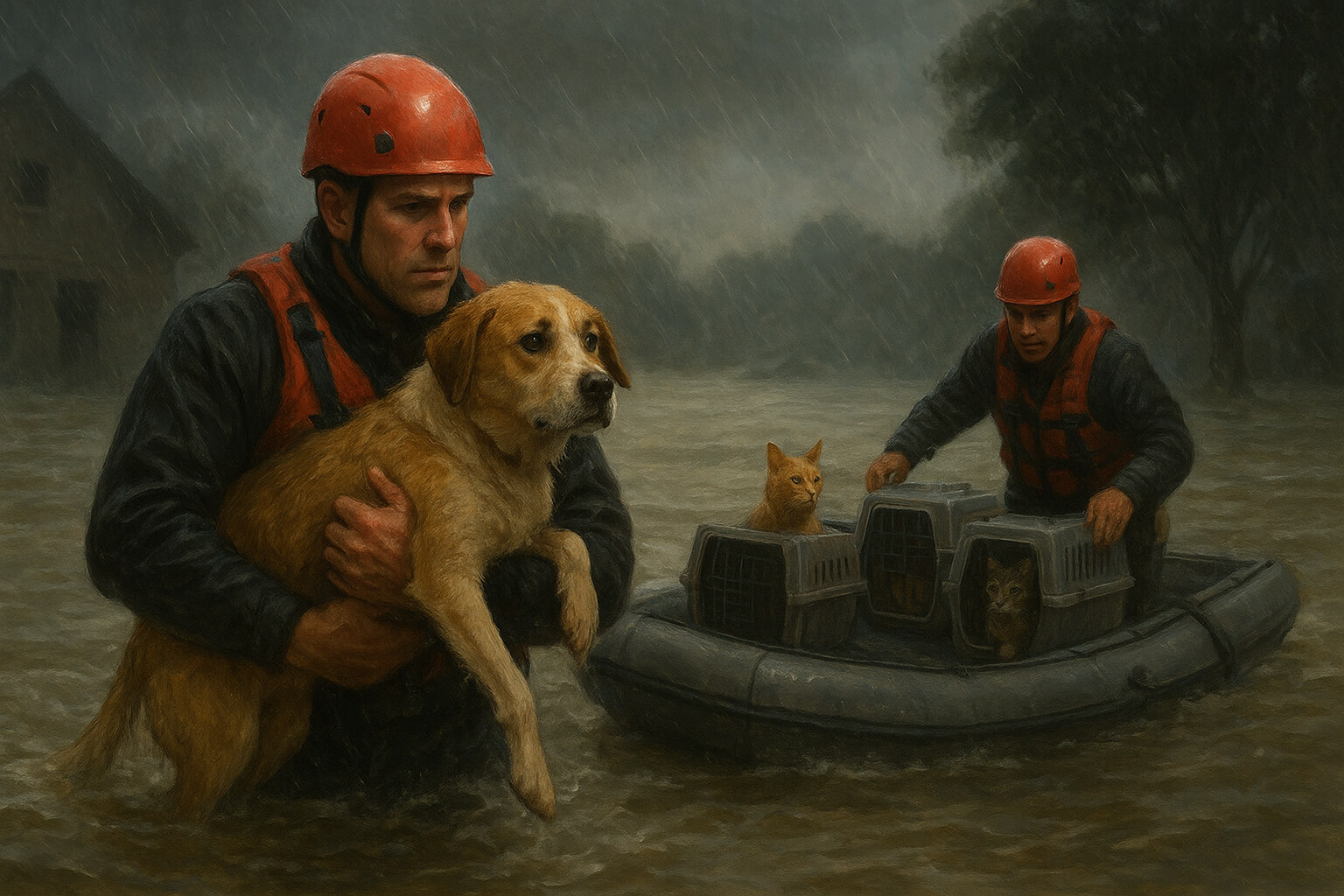Natural disasters—whether wildfires, hurricanes, floods, or earthquakes—are unpredictable and often devastating. In their wake, families scramble to stay safe, communities struggle to rebuild, and first responders rush to provide aid. But in the urgency of these moments, one group is often overlooked: animals.
Whether they’re beloved pets, injured wildlife, or farm animals caught in the chaos, animals are vulnerable during crises. And yet, they are rarely part of the core emergency planning process. That gap can mean the difference between survival and suffering—not just for the animals, but also for the humans who love and depend on them.
Protecting animals in disasters isn’t just compassionate—it’s critical. It strengthens community trust, aids human recovery, and saves countless lives, both human and non-human.
Why Animal Protection Matters in Disasters
When families are forced to evacuate, many are faced with heartbreaking decisions. Pet-friendly shelters may be full—or nonexistent. Transport options are limited. And emergency responders can’t always prioritize animals in the initial chaos.
But the impact of leaving pets behind is profound:
- Pets are often traumatized by being abandoned, and may suffer injury, dehydration, or starvation.
- Wild animals may be burned out of their habitats or injured by debris and pollution.
- Livestock and farm animals, unable to be moved quickly, can perish or become stranded for days.
Beyond the moral responsibility, there’s a practical one: research shows that people are more likely to refuse evacuation if they can’t bring their pets. That puts human lives at risk too.
Animal rescue organizations—often operating with limited funding and volunteers—play a critical role by:
- Organizing pet evacuations and emergency sheltering
- Offering immediate veterinary care
- Coordinating with foster families and animal shelters
- Spreading awareness about disaster preparedness for pet owners
Much like how musicians prepare for creativity with the right tools (see Understanding Sample Packs), communities must prepare before disaster hits to ensure all lives can be protected.
How Emergency Animal Rescue Works
When disaster strikes, animal rescue teams don’t hesitate. They go directly into danger zones—sometimes alongside other emergency responders, sometimes entirely on their own.
Their responsibilities are diverse and demanding:
Search and Rescue
- Rescue teams comb through flooded homes, collapsed buildings, or scorched landscapes to find trapped animals. Some use boats, drones, or thermal imaging cameras to locate those that can’t be seen.
Emergency Veterinary Care
- Mobile clinics or pop-up tents are set up in parking lots or near shelters to provide triage for wounds, infections, or burns.
Temporary Housing and Reunification
- Pets are placed in emergency shelters until their families can reclaim them—or in foster homes where they receive comfort and attention. Microchipping, ID tags, and photos are crucial tools in the reunification process.
Wildlife Response
- Wildlife responders rescue and rehabilitate displaced or injured animals—birds that can’t fly due to smoke inhalation, deer with burned hooves, turtles swept inland by floods.
These efforts, while urgent, are only effective if the right support systems are in place—trained personnel, supplies, vehicles, and coordination with human services.
Preparing Communities to Protect Animals
Emergency preparedness saves lives—and not just human ones. When families, neighborhoods, and local governments plan for animal safety in advance, the chaos of a disaster becomes much more manageable.
Steps communities and individuals can take include:
- Create a pet disaster kit. Include a leash, collar, food, water, bowls, copies of vet records, medications, and a photo of your pet.
- Know your local options. Research pet-friendly hotels and shelters before you need them.
- Microchip your pets. Collars can fall off—but a chip can speak for your pet when you can’t.
- Talk to neighbors. In case you’re not home, a neighbor can help evacuate your pets if a plan is in place.
- Volunteer or donate. Local shelters and animal disaster response teams rely on community support year-round, not just during crises.
Preparedness can be built step by step—just like learning a new skill or instrument, as described in The Ultimate Guide to Music Reading for Beginners.
Stories of Compassion and Survival
- During Hurricane Katrina in 2005, over 250,000 pets were left behind. Some perished. Others were rescued weeks or even months later by volunteers and transported across the country. This tragedy sparked national awareness, leading to the passage of the PET Act in 2006, which required government agencies to include pets in disaster plans.
- More recently, during wildfires in California and floods in Texas, thousands of animals have been saved by local and national rescue groups working tirelessly around the clock. Volunteers have carried dogs through waist-high water, bottle-fed orphaned kittens, and set up emergency barns for displaced livestock.
- Each rescue represents not just survival—but hope. Families have reunited with lost pets, children have had their comfort animals returned, and communities have come together around the shared value of compassion.
Strengthening the Human–Animal Bond
- When communities see animals being rescued, cared for, and reunited with their humans, it sends a powerful message: every life matters. It also builds trust in emergency services, inspires people to get involved, and encourages donations and long-term support for animal organizations.
- Animal rescue during disasters isn’t just a service. It’s a statement about who we are—and what we value.
Final Takeaway: Don’t Wait. Prepare Now.
Disasters can strike without warning, but preparation gives us the power to respond with compassion and confidence.
Protecting animals during emergencies is not a secondary concern. It is an essential part of a safe, resilient, and humane response. It keeps families whole, reduces trauma, and upholds the values of empathy and responsibility.
Whether you're a pet owner, a community leader, a teacher, or simply someone who cares—your actions today can make a life-saving difference tomorrow.
Start by:
- Preparing your home and pets
- Supporting your local animal rescue organizations
- Spreading the message of preparedness
Together, we can build a world where no one—human or animal—is left behind.
